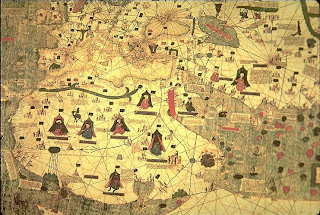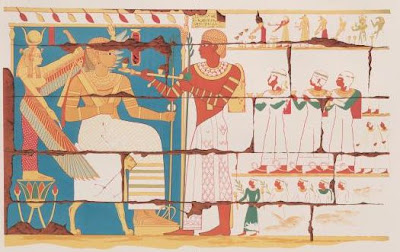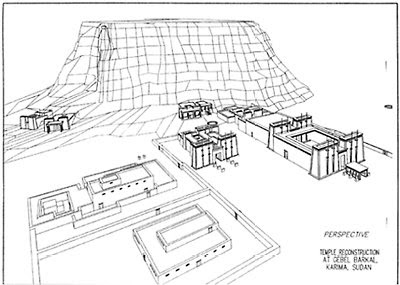

Catalan-Estense Map, detail: Asia, Eastern Africa, Middle East
TITLE: Catalan-Estense World Map
DATE: 1450-1460
AUTHOR: unknown
DESCRIPTION: The oldest of the portolan [nautical] charts to survive are of Italian origin, made at Genoa and Pisa; those dating from the latter half of the 14th century are mainly Catalan. But the typical Catalan map is not strictly speaking a portolan chart. It is more than that; for while the latter is essentially a sailing guide concerned with coast wise navigation, the Catalan map is really a world map built up around the portolan chart. It is true that in some cases the term 'world' connotes simply the habitable earth as known by the author, nevertheless, in others, as the Catalan-Estense map, it is interpreted to include lands not yet discovered, but only posited. This aggravated the cartographer's task very considerably for it meant that he was continually being faced with the problem of choosing between scanty and often poorly substantiated fact on the one hand, and plausible and often well-attested theory on the other. It is a tribute to the integrity of these men that their work contains so much that subsequent investigation has proved true. In fact it is this careful sifting of evidence that constitutes one of the chief merits of the Catalan school of cartography, in an age when intellectual honesty was none too common. The value of the Catalan maps, as commentaries upon the state of contemporary knowledge at once becomes apparent and we are hardly surprised to find that the Catalan Atlas of 1375 has the finest delineation of Asia the world had seen up to that time, or that, in its knowledge of Cathay [China] and the Sudan, the same map is surpassed in the Middle Ages only by the 1459 Fra Mauro map. all of approximately the same date, ca.1450. According to Kimble, there are at least three distinct influences, in addition to the portolan chart tradition, that can be detected. These influences are Classical, Christian and Arab. Of these only the Arab influence is strong, while it is improbable that the Classical influence was direct. Thus, in the case of the Catalan-Estense map, it owes nothing to the Ptolemaic tradition, and it is less likely that its author should have taken his idea of a southern continent direct from Crates, the originator of the concept (150 B.C.),
than that he should have taken it from Arab or Christian cosmographers, such as Abu'l Fida or Isidore, who revived it. The influence of the medieval Christian tradition on the Catalan-Estense map is betrayed in such elements as the legend relating to Prester John and the portrayal of the Terrestrial Paradise . There can be no mistaking the Arab influence. We have only to compare the delineation of the southern half of Africa on the map with the description given by the 11th century writer, Al-Biruni, of the shores of the Southern Ocean to be convinced of the kinship. Thus, the Catalan-Estense map, although embellished with castellated towns, ships and portraits of African princes, attempts to furnish an up-to-date picture of the world and to resolve the ancient riddle of Africa nondum cognita.
The circular Catalan-Estense map, measuring 113 cm in diameter, is very colorful with a large number of princes shown throughout Africa (where Prester John has been placed), 52 legends, castellated towns for major settlements, loxodromes, ships, mermaids, domesticated reindeer and horses. Although almost a hundred years later, it is clearly related to the pivotal Catalan Atlas of 1375. This resemblance in the content of the two maps strengthens the contention that the latter was derived from a circular prototype. The nomenclature and the numerous legends on the Catalan-Estense , mostly in Catalan with a few in corrupt Latin, are often very similar to those of the 1375 Atlas . In some instances the legends are more complete, in others they are less detailed; they suggest, therefore, not direct copying but possibly a common source. This similarity is also evident in the delineation of the main features, most of those in the 1375 Atlas are to be found on the Estense map.
The northern portions of Asia and Europe on the Estense map, which lay outside the limits of the Catalan Atlas , significantly, contain very little detail. On the southern coastline of Asia there are some differences, generally slight, between the two maps. The peninsula of India is much less pronounced on the Catalan-Estense map, and to the south is the large island of Salam or Silan [Ceylon/Sri Lanka] which also fell outside the physical limits of the Catalan Atlas . A legend refers to its wealth in rubies and other precious stones. There can be no doubt however that the two outlines are fundamentally identical. To the east is the island of Java, as on the Catalan Atlas . The island of Trapobana is much enlarged, and is placed on the southeastern margin of the map. The surrounding ocean, the Mar deles indies is filled with numerous nameless and featureless islands.
Africa occupies most of the southern half of the map. The continent ends in a great arc, conforming to the circular frame of the map, and extending eastwards to form the southern boundary of the Indian Ocean. On the west, a long narrow gulf from the circumfluent ocean almost severs this southerly projection from northern Africa. The southern interior is blank save for the legend Africa begins at the river Nile in Egypt and ends at Gutzola in the west: it includes the whole land of Barbaria, and the land in the south. This outline and legend have been interpreted to imply some knowledge of the southern extremity of Africa, and perhaps of a practicable route from the west to the Indian Ocean.
That the great western gulf reflects some knowledge of the Gulf of Guinea is more probable. The design of the northern half of the continent in general resembles that of the other Catalan charts, but the northwestern coast embodies some details of contemporary Portuguese voyages as far as C. ude [Cape Verde] and C. groso . From this evidence, the map is usually dated about 1450. Near the gulf are the Mountains of the Moon , from which five rivers flow northwards to a lake on the western Nile . This lake probably represents the area around the Upper Niger liable to inundation; Kimble has pointed out that these rivers may well represent the five main sources of the Niger. These Mountains of the Moon are stated to be on the Equator, and the streams are called the riu de lor . We may therefore assume that the headwaters of the Niger marked the approximate limit of contemporary knowledge in this region, and it is not improbable that reports of the sea to the south had been received. These may have induced the cartographer to accept the western gulf of Ptolemy, but to enlarge it considerably. Again, the name Rio del Oro [river of gold] recalls the inscription on the Catalan Atlas and the classical tradition. The portrayal of the interior thus goes back at least to 1375. Apart therefore from a small portion of the coastline, the map owes nothing to Portuguese exploration.
Some surprise has been expressed that a map of 1450 should contain relatively up-to-date details coupled with antiquated ideas in other areas, and this has produced some rather involved explanations. Taking into consideration the lack of details and names in the southern regions of Africa, we may plausibly conjecture that, as an exception to the usual conservatism, the draftsman, in Africa at least, had removed all the detail for which he had no evidence, to obtain a framework on which to insert the latest Portuguese discoveries. It must remain debatable whether the outline of the southern extremity represents some knowledge of the Cape. The outline may be entirely imposed by the frame of the map: at the most, it may reflect the kind of report that we find on Fra Mauro's map .
The merit of the Catalan cartographers lay in the skill with which they employed the best contemporary sources to modify the traditional world picture, rarely proceeding further than the evidence warranted. In the same spirit they removed from the map most of the traditional fables which had been accepted for centuries, and preferred, for example, to omit the northern and southern regions entirely, or to leave southern Africa a blank rather than to fill it with the Anthropagi and other monsters which adorn so many medieval maps. Though drawings of men and animals still figure on their works they are in the main those for which there was some contemporary, or nearly contemporary, warrant; for example, Mansa Musa , the lord of Guinea, whose pilgrimage to Mecca created a sensation in 1324, or Olub bein , the ruler of the Tatars. In this spirit of critical realism, the Catalan cartographers of the 14th century threw off the bonds of tradition, and anticipated the achievements of the Renaissance.
LOCATION: Biblioteca Estense, Modena, Italy
REFERENCES:
*Bagrow, L., History of Cartography, plate XLIII.
*Cardini, F., Europe 1492, p. 208 (color).
Crone, G.R., Maps and Their Makers, pp. 47-50.
*Destombes, M., Mappemondes, A.D. 1200-1500, pp. 217-221, plate XXXIII.
*George, W., Animals and Maps, pp.13, 39-43, 48-49.
*Gross, J., Mapmakers' Art, p. 45 (color)
*Kimble, G.H.T., Geography in the Middle Ages, pp. 113, 182-3, 194-197.
*Skelton, R.A., The Vinland Map and the Tartar Relation, pp. 113, 118-19, 127, 131, 250, plate XI





























